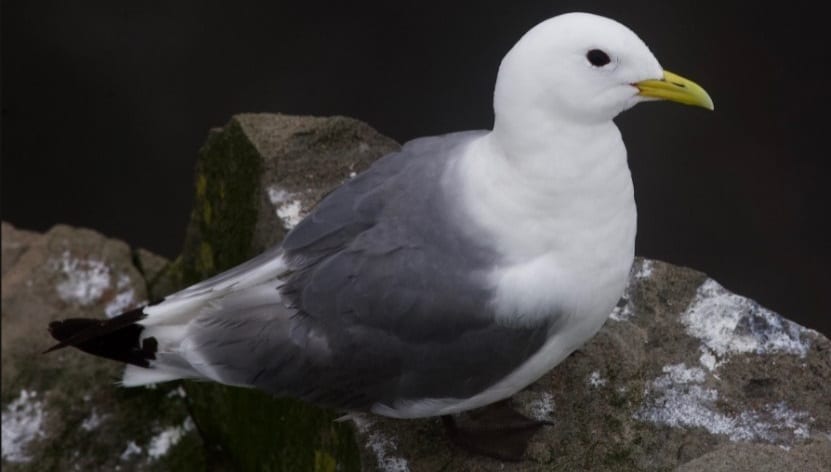
Maine’s Offshore Wind Roadmap is part of a state initiative to guide the development of offshore wind, led by an expert advisory committee and working groups, including Maine Audubon staff. The Roadmap focuses on a variety of topics related to the development of offshore wind, including energy markets, ports and infrastructure, socioeconomic impacts, equity, manufacturing and supply chains, workforce development, and, especially important to Maine Audubon, wildlife and environmental compatibility.
Each of the four Working Groups have developed a set of recommendations. Those recommendations are open to feedback for the public, and comments are due by April 30, 2022. We hope you’ll add your voice.
On April 19, 2022, Maine Audubon held a webinar on Roadmap progress featuring Deputy Director Celina Cunningham of the Governor’s Energy Office, alongside Maine Audubon’s Conservation Biologist Sarah Haggerty and Advocacy Director Eliza Donoghue. The panelists outlined the background and goals of the Roadmap, Maine Audubon’s input into the Environment and Wildlife Working Group, as well as an outline of how to comment. View a recording of that program below:
- Map Existing Data. Several groups have agreed on the need to map the various uses and areas of the ocean, including fishing groups. For wildlife, important info to be mapped include bird foraging areas, migratory pathways, deep-water corals and other unique habitats, spawning and feeding areas, and hotspots for Calanus copepods.
- Collect Gulf of Maine Habitat Information. Important here is collecting high-quality seafloor data, setting up a mapping collaborative, and pursuing federal funding.
- Collect Gulf of Maine Baseline Data. Want to better understand baseline ecological data to determine impacts later on, including migratory information, nocturnal use, and other uses.
- Conduct Tracking Studies. Relatedly, conducting tracking studies utilizing the extensive motus network in New England and maritime Canada will help understand what species are using the Gulf, when and where. Additional studies can track fish and marine mammals.
- Explore Federal Consistency. The Working Group recommends coordination with neighboring states under the Coastal Zone Management Act to better understand regulation and responsibilities for offshore wind in the Gulf.
HOW TO ADD YOUR COMMENTS
The state is looking for public comments on the Working Group recommendations, and comments are open until April 30, 2022. However, the commenting site is extensive and potentially confusing, so below is a guide to navigating the commenting system and suggested comments. Of course, your comments are up to you.
- First, visit the Maine Offshore Wind Initiative Feedback Page here. The form includes four questions.
- The first question asks the reader to pick the two Environment and Wildlife Working Group (EWWG) recommendations that they believe to be the most strategically important for Maine right now.
- Maine Audubon believes that each of the five recommendations are crucial. However, for the sake of this exercise, we selected “COLLECT GOM BASELINE INFORMATION” and “CONDUCT TRACKING STUDIES”.
- The second question asks which are the two lowest priority recommendations for Maine.
- Again, we disagree with the premise of the question and believe that all recommendations should be actively pursued. However, for the sake of the exercise, we have selected “MAP EXISTING DATA” and “EXPLORE USE OF FEDERAL CONSISTENCY”.
- The third asks how the reader would improve or add to the initial recommendations. In our response, we shared:
- We disagree with the premise of Question 2; all recommendations should be actively pursued.
- We urged the EWWG to include recommendations on the topics slated for future discussion (see the final page of their draft recommendations) in their final product. These topics, including best management practices for pre- and post-construction monitoring and mitigation requirements, are essential for understanding how offshore wind development can coexist with wildlife in the Gulf. We trust in the expertise and experience represented on the EWWG and are confident in their ability to develop recommendations that embrace the critical role offshore wind will play in our climate future, as well as the necessity of conserving the Gulf’s wildlife and environment.
- Data collection should be standardized, aggregated across regions and projects, and made publicly available in order to maximize learning, understand regional impacts, and create transparency.
- As new wildlife and habitat impact reduction technologies and information become available, it should be utilized in all planning, permitting, and new projects, as well as existing projects, to the extent possible.
- Cumulative impacts from offshore wind development must be routinely assessed, addressed, and planned for to the greatest extent practicable. Impacts must be measured across the Eastern seaboard, because many impacted species’ habitats span the entire coast.
- Finally, the last question asks for other information or ideas that may be useful for the Roadmap.
- In our answer to this question, Maine Audubon encouraged Maine people and decision-makers to move swiftly toward embracing offshore wind that not only is sited, operated, and studied with wildlife and habitat in mind, but that is also cost-effective and that utilizes the skills and resources of Maine workers.
- While Maine Audubon’s focus is the intersection of OSW and wildlife, as well as the role that OSW can play in helping Maine meet its renewable energy goals, we know that if OSW is going to work, it needs to work for all Maine people. That means Maine jobs, reasonable electricity rates, and utilizing the technology developed by UMaine.
We hope you take the time to add your voice to this critical conversation.
